Investigating Value Chain Strategies in Taiwan High Tech Companies
VerifiedAdded on 2020/01/06
|5
|1338
|185
Report
AI Summary
This dissertation chapter investigates the value chain strategies of Original Brand Manufacturers (OBM) and Original Design Manufacturers (ODM) in Taiwan's high-tech industry, aiming to understand how they differentiate and gain a competitive edge. The discussion synthesizes findings from primary and secondary research, comparing OBM and ODM strategies in supplier selection, target setting, and responses to market changes. The research highlights that ODM firms prioritize cost in supplier selection, while OBMs focus on new product development. The study also examines how these companies approach product development, pricing, market entry, and supplier relationships. The research reveals that ODM companies often emphasize reducing logistic costs and lowering product prices, while OBMs concentrate on brand differentiation, new product categories, and higher market share. The study also addresses value chain strategies in response to shifts in bargaining power and explores the perspectives of ODM managers on transitioning to an OBM model. The analysis incorporates insights from relevant literature, including works by Porter, Barney, and Grant, to provide a comprehensive understanding of value chain dynamics in the Taiwanese high-tech sector.
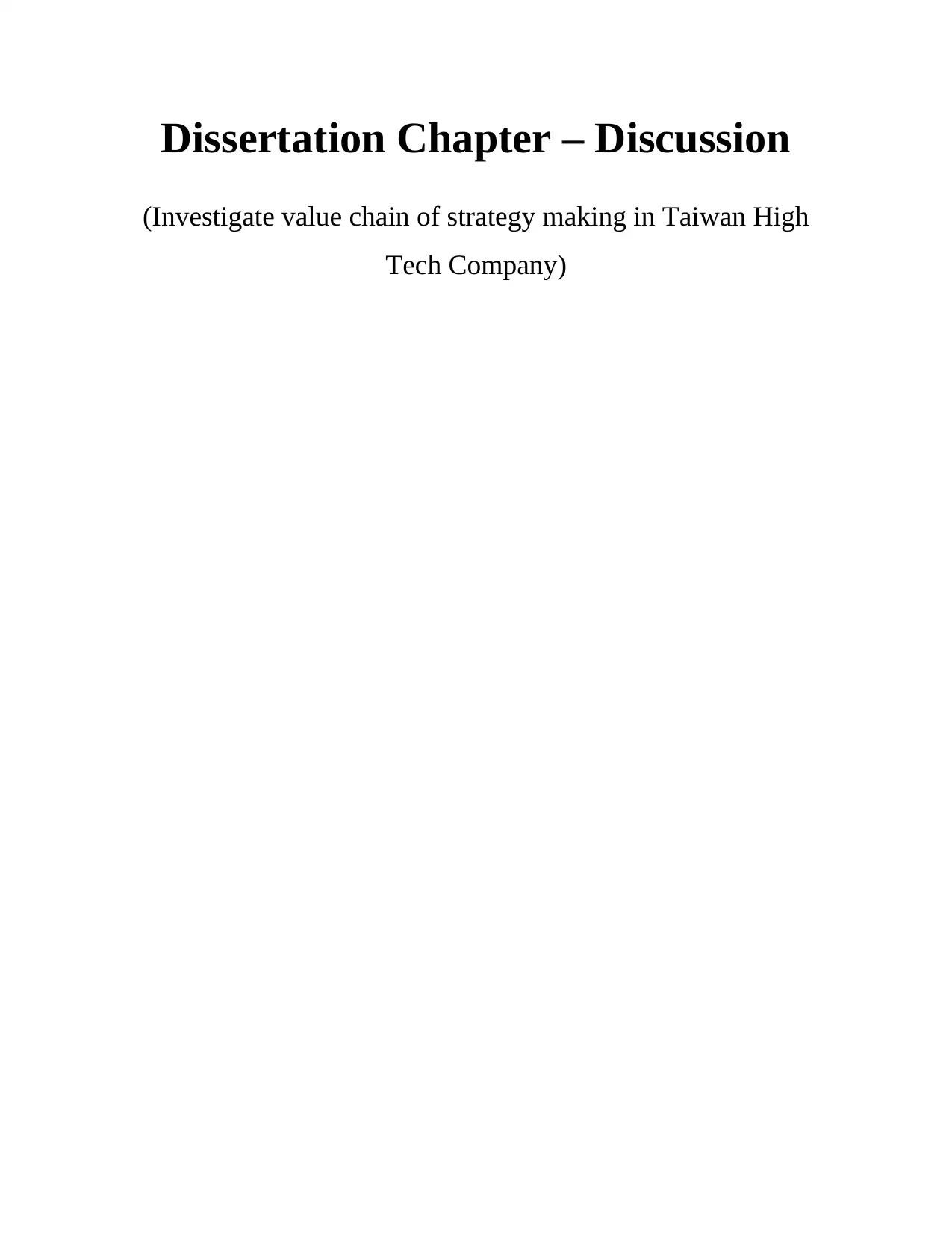
Dissertation Chapter – Discussion
(Investigate value chain of strategy making in Taiwan High
Tech Company)
(Investigate value chain of strategy making in Taiwan High
Tech Company)
Paraphrase This Document
Need a fresh take? Get an instant paraphrase of this document with our AI Paraphraser
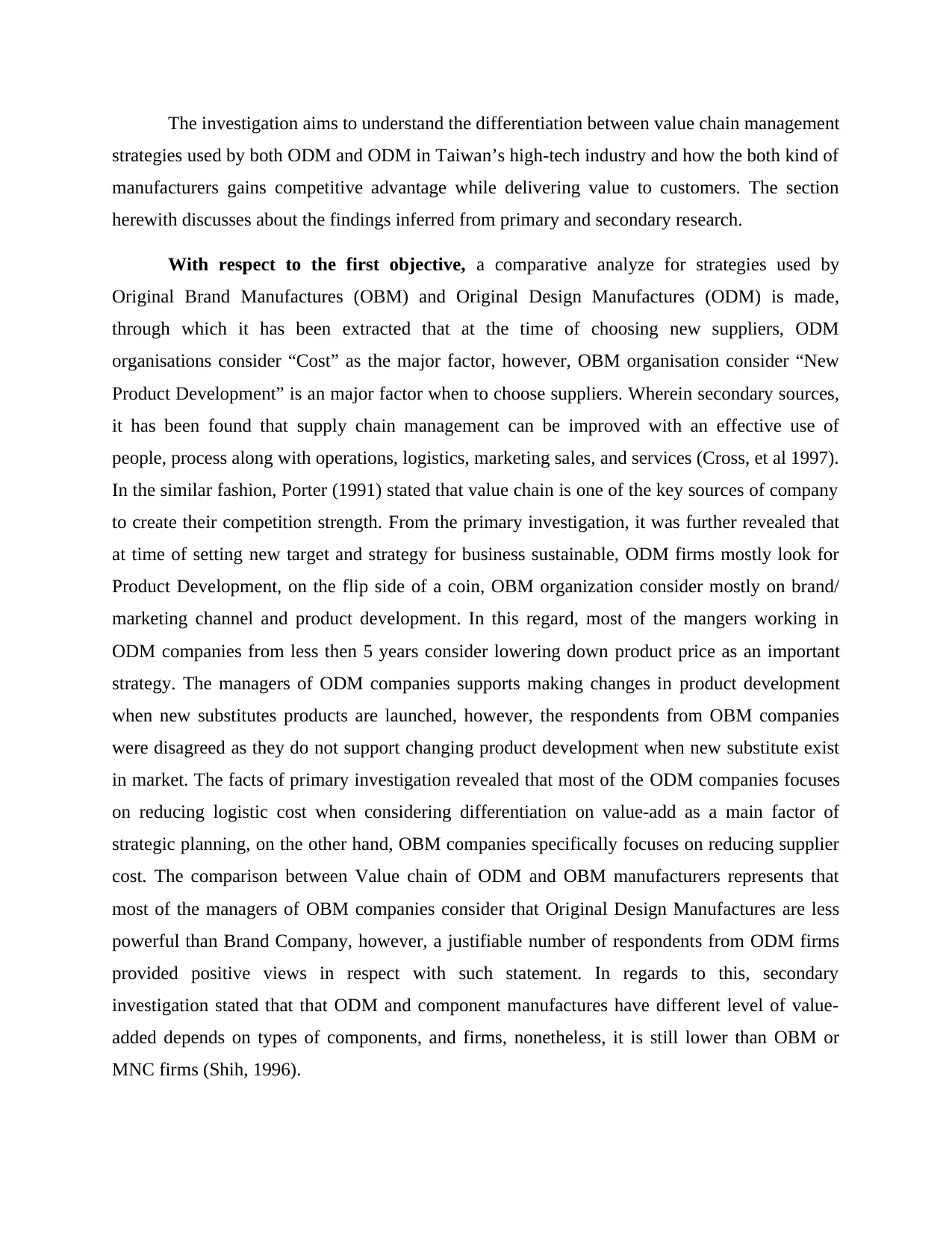
The investigation aims to understand the differentiation between value chain management
strategies used by both ODM and ODM in Taiwan’s high-tech industry and how the both kind of
manufacturers gains competitive advantage while delivering value to customers. The section
herewith discusses about the findings inferred from primary and secondary research.
With respect to the first objective, a comparative analyze for strategies used by
Original Brand Manufactures (OBM) and Original Design Manufactures (ODM) is made,
through which it has been extracted that at the time of choosing new suppliers, ODM
organisations consider “Cost” as the major factor, however, OBM organisation consider “New
Product Development” is an major factor when to choose suppliers. Wherein secondary sources,
it has been found that supply chain management can be improved with an effective use of
people, process along with operations, logistics, marketing sales, and services (Cross, et al 1997).
In the similar fashion, Porter (1991) stated that value chain is one of the key sources of company
to create their competition strength. From the primary investigation, it was further revealed that
at time of setting new target and strategy for business sustainable, ODM firms mostly look for
Product Development, on the flip side of a coin, OBM organization consider mostly on brand/
marketing channel and product development. In this regard, most of the mangers working in
ODM companies from less then 5 years consider lowering down product price as an important
strategy. The managers of ODM companies supports making changes in product development
when new substitutes products are launched, however, the respondents from OBM companies
were disagreed as they do not support changing product development when new substitute exist
in market. The facts of primary investigation revealed that most of the ODM companies focuses
on reducing logistic cost when considering differentiation on value-add as a main factor of
strategic planning, on the other hand, OBM companies specifically focuses on reducing supplier
cost. The comparison between Value chain of ODM and OBM manufacturers represents that
most of the managers of OBM companies consider that Original Design Manufactures are less
powerful than Brand Company, however, a justifiable number of respondents from ODM firms
provided positive views in respect with such statement. In regards to this, secondary
investigation stated that that ODM and component manufactures have different level of value-
added depends on types of components, and firms, nonetheless, it is still lower than OBM or
MNC firms (Shih, 1996).
strategies used by both ODM and ODM in Taiwan’s high-tech industry and how the both kind of
manufacturers gains competitive advantage while delivering value to customers. The section
herewith discusses about the findings inferred from primary and secondary research.
With respect to the first objective, a comparative analyze for strategies used by
Original Brand Manufactures (OBM) and Original Design Manufactures (ODM) is made,
through which it has been extracted that at the time of choosing new suppliers, ODM
organisations consider “Cost” as the major factor, however, OBM organisation consider “New
Product Development” is an major factor when to choose suppliers. Wherein secondary sources,
it has been found that supply chain management can be improved with an effective use of
people, process along with operations, logistics, marketing sales, and services (Cross, et al 1997).
In the similar fashion, Porter (1991) stated that value chain is one of the key sources of company
to create their competition strength. From the primary investigation, it was further revealed that
at time of setting new target and strategy for business sustainable, ODM firms mostly look for
Product Development, on the flip side of a coin, OBM organization consider mostly on brand/
marketing channel and product development. In this regard, most of the mangers working in
ODM companies from less then 5 years consider lowering down product price as an important
strategy. The managers of ODM companies supports making changes in product development
when new substitutes products are launched, however, the respondents from OBM companies
were disagreed as they do not support changing product development when new substitute exist
in market. The facts of primary investigation revealed that most of the ODM companies focuses
on reducing logistic cost when considering differentiation on value-add as a main factor of
strategic planning, on the other hand, OBM companies specifically focuses on reducing supplier
cost. The comparison between Value chain of ODM and OBM manufacturers represents that
most of the managers of OBM companies consider that Original Design Manufactures are less
powerful than Brand Company, however, a justifiable number of respondents from ODM firms
provided positive views in respect with such statement. In regards to this, secondary
investigation stated that that ODM and component manufactures have different level of value-
added depends on types of components, and firms, nonetheless, it is still lower than OBM or
MNC firms (Shih, 1996).
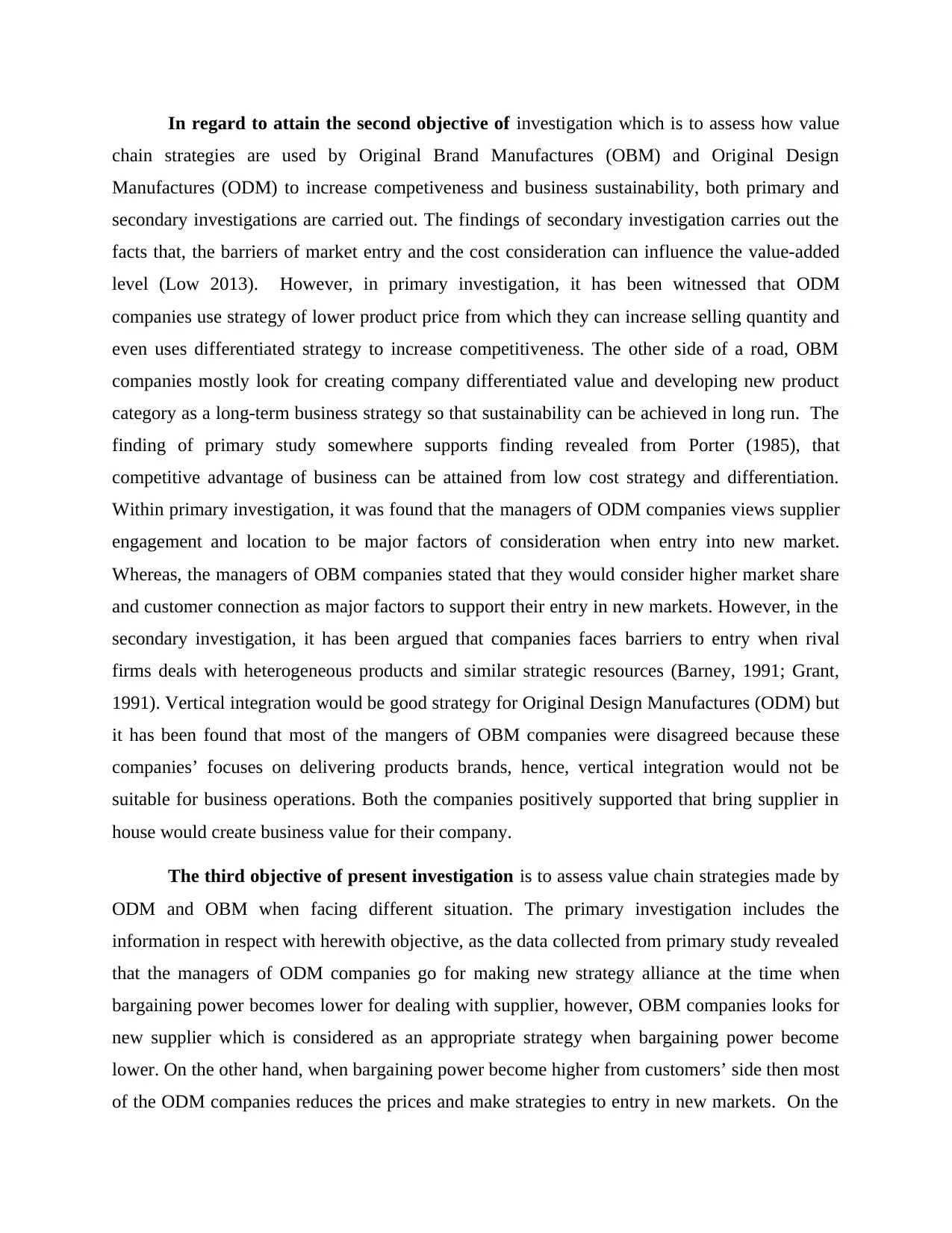
In regard to attain the second objective of investigation which is to assess how value
chain strategies are used by Original Brand Manufactures (OBM) and Original Design
Manufactures (ODM) to increase competiveness and business sustainability, both primary and
secondary investigations are carried out. The findings of secondary investigation carries out the
facts that, the barriers of market entry and the cost consideration can influence the value-added
level (Low 2013). However, in primary investigation, it has been witnessed that ODM
companies use strategy of lower product price from which they can increase selling quantity and
even uses differentiated strategy to increase competitiveness. The other side of a road, OBM
companies mostly look for creating company differentiated value and developing new product
category as a long-term business strategy so that sustainability can be achieved in long run. The
finding of primary study somewhere supports finding revealed from Porter (1985), that
competitive advantage of business can be attained from low cost strategy and differentiation.
Within primary investigation, it was found that the managers of ODM companies views supplier
engagement and location to be major factors of consideration when entry into new market.
Whereas, the managers of OBM companies stated that they would consider higher market share
and customer connection as major factors to support their entry in new markets. However, in the
secondary investigation, it has been argued that companies faces barriers to entry when rival
firms deals with heterogeneous products and similar strategic resources (Barney, 1991; Grant,
1991). Vertical integration would be good strategy for Original Design Manufactures (ODM) but
it has been found that most of the mangers of OBM companies were disagreed because these
companies’ focuses on delivering products brands, hence, vertical integration would not be
suitable for business operations. Both the companies positively supported that bring supplier in
house would create business value for their company.
The third objective of present investigation is to assess value chain strategies made by
ODM and OBM when facing different situation. The primary investigation includes the
information in respect with herewith objective, as the data collected from primary study revealed
that the managers of ODM companies go for making new strategy alliance at the time when
bargaining power becomes lower for dealing with supplier, however, OBM companies looks for
new supplier which is considered as an appropriate strategy when bargaining power become
lower. On the other hand, when bargaining power become higher from customers’ side then most
of the ODM companies reduces the prices and make strategies to entry in new markets. On the
chain strategies are used by Original Brand Manufactures (OBM) and Original Design
Manufactures (ODM) to increase competiveness and business sustainability, both primary and
secondary investigations are carried out. The findings of secondary investigation carries out the
facts that, the barriers of market entry and the cost consideration can influence the value-added
level (Low 2013). However, in primary investigation, it has been witnessed that ODM
companies use strategy of lower product price from which they can increase selling quantity and
even uses differentiated strategy to increase competitiveness. The other side of a road, OBM
companies mostly look for creating company differentiated value and developing new product
category as a long-term business strategy so that sustainability can be achieved in long run. The
finding of primary study somewhere supports finding revealed from Porter (1985), that
competitive advantage of business can be attained from low cost strategy and differentiation.
Within primary investigation, it was found that the managers of ODM companies views supplier
engagement and location to be major factors of consideration when entry into new market.
Whereas, the managers of OBM companies stated that they would consider higher market share
and customer connection as major factors to support their entry in new markets. However, in the
secondary investigation, it has been argued that companies faces barriers to entry when rival
firms deals with heterogeneous products and similar strategic resources (Barney, 1991; Grant,
1991). Vertical integration would be good strategy for Original Design Manufactures (ODM) but
it has been found that most of the mangers of OBM companies were disagreed because these
companies’ focuses on delivering products brands, hence, vertical integration would not be
suitable for business operations. Both the companies positively supported that bring supplier in
house would create business value for their company.
The third objective of present investigation is to assess value chain strategies made by
ODM and OBM when facing different situation. The primary investigation includes the
information in respect with herewith objective, as the data collected from primary study revealed
that the managers of ODM companies go for making new strategy alliance at the time when
bargaining power becomes lower for dealing with supplier, however, OBM companies looks for
new supplier which is considered as an appropriate strategy when bargaining power become
lower. On the other hand, when bargaining power become higher from customers’ side then most
of the ODM companies reduces the prices and make strategies to entry in new markets. On the
⊘ This is a preview!⊘
Do you want full access?
Subscribe today to unlock all pages.

Trusted by 1+ million students worldwide
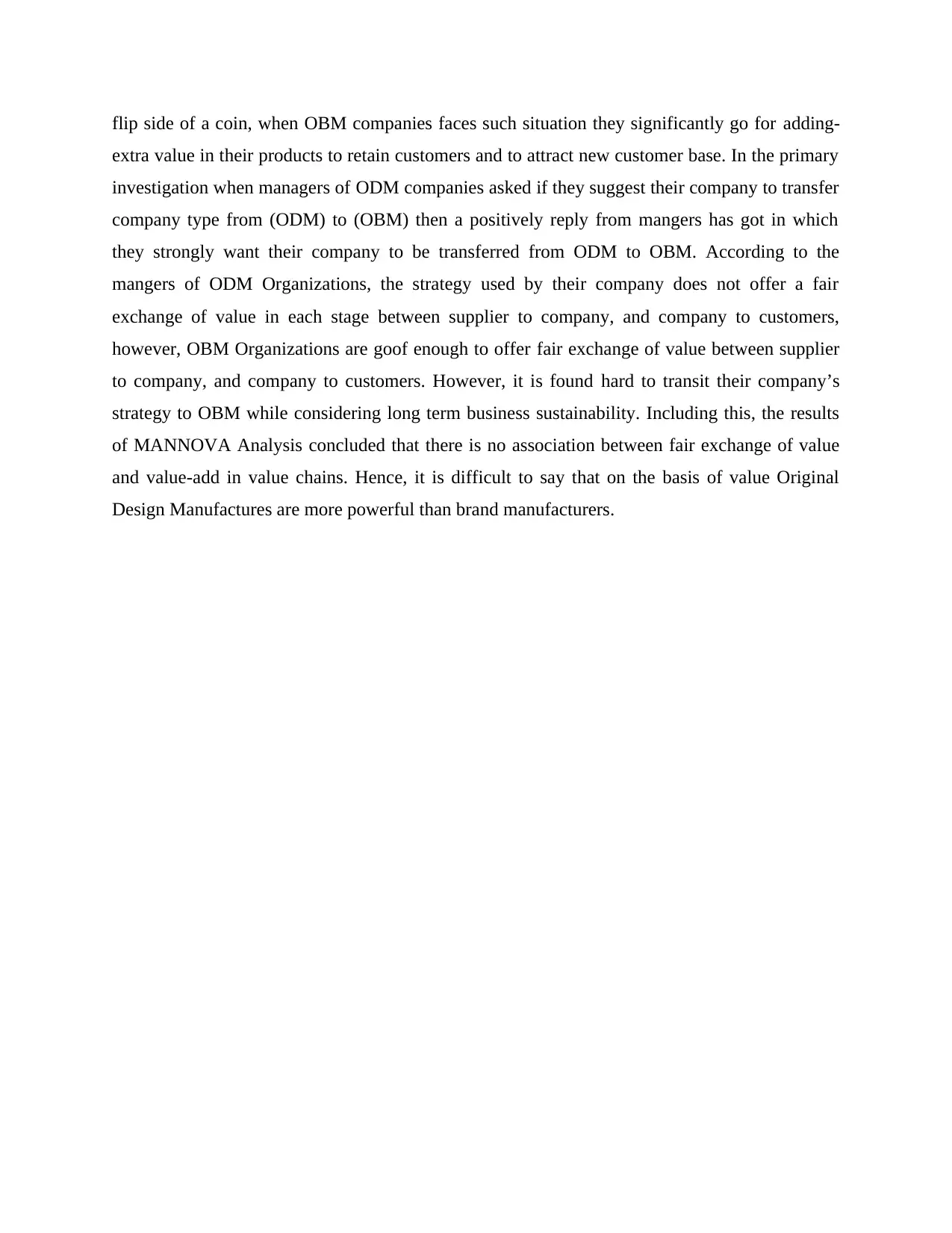
flip side of a coin, when OBM companies faces such situation they significantly go for adding-
extra value in their products to retain customers and to attract new customer base. In the primary
investigation when managers of ODM companies asked if they suggest their company to transfer
company type from (ODM) to (OBM) then a positively reply from mangers has got in which
they strongly want their company to be transferred from ODM to OBM. According to the
mangers of ODM Organizations, the strategy used by their company does not offer a fair
exchange of value in each stage between supplier to company, and company to customers,
however, OBM Organizations are goof enough to offer fair exchange of value between supplier
to company, and company to customers. However, it is found hard to transit their company’s
strategy to OBM while considering long term business sustainability. Including this, the results
of MANNOVA Analysis concluded that there is no association between fair exchange of value
and value-add in value chains. Hence, it is difficult to say that on the basis of value Original
Design Manufactures are more powerful than brand manufacturers.
extra value in their products to retain customers and to attract new customer base. In the primary
investigation when managers of ODM companies asked if they suggest their company to transfer
company type from (ODM) to (OBM) then a positively reply from mangers has got in which
they strongly want their company to be transferred from ODM to OBM. According to the
mangers of ODM Organizations, the strategy used by their company does not offer a fair
exchange of value in each stage between supplier to company, and company to customers,
however, OBM Organizations are goof enough to offer fair exchange of value between supplier
to company, and company to customers. However, it is found hard to transit their company’s
strategy to OBM while considering long term business sustainability. Including this, the results
of MANNOVA Analysis concluded that there is no association between fair exchange of value
and value-add in value chains. Hence, it is difficult to say that on the basis of value Original
Design Manufactures are more powerful than brand manufacturers.
Paraphrase This Document
Need a fresh take? Get an instant paraphrase of this document with our AI Paraphraser
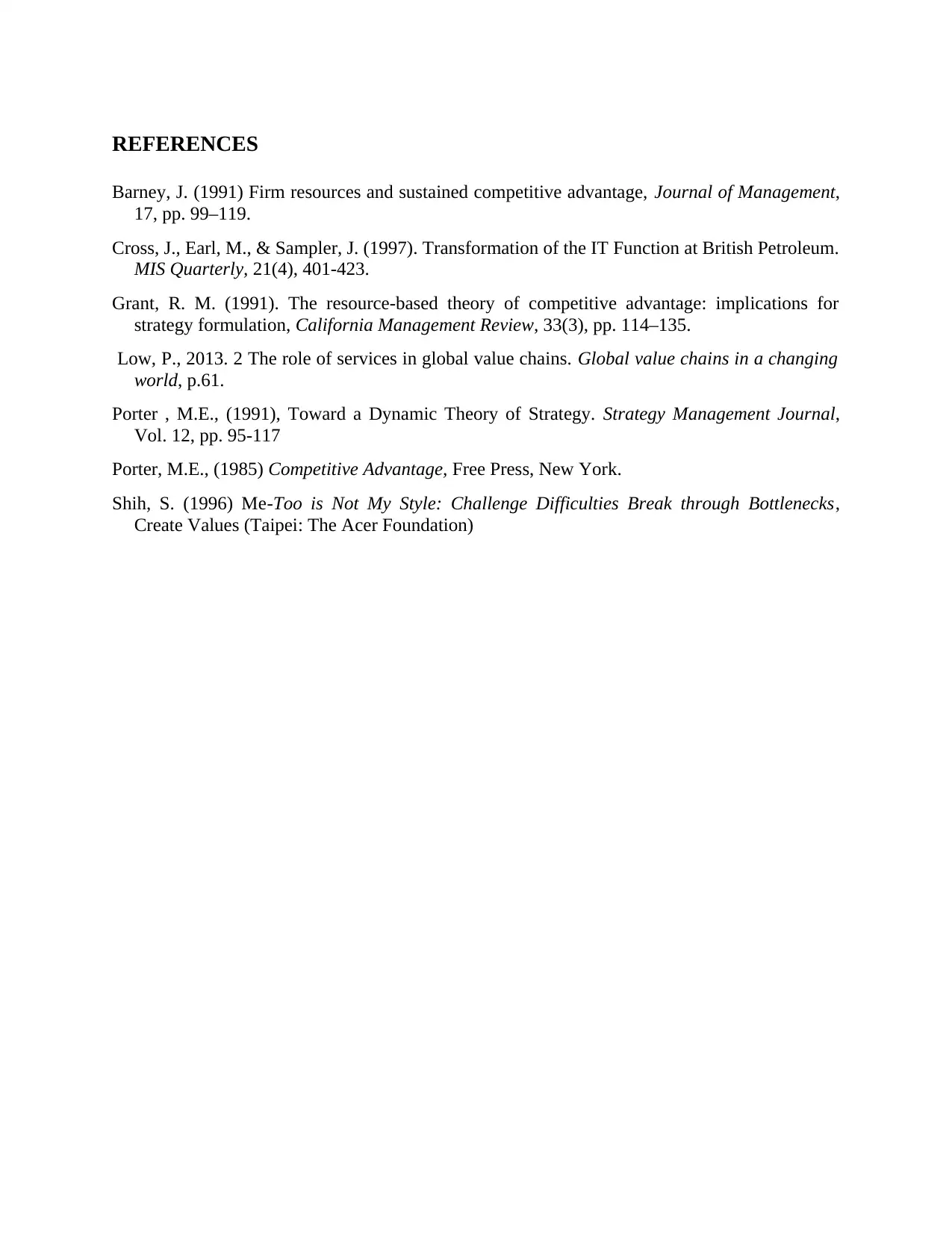
REFERENCES
Barney, J. (1991) Firm resources and sustained competitive advantage, Journal of Management,
17, pp. 99–119.
Cross, J., Earl, M., & Sampler, J. (1997). Transformation of the IT Function at British Petroleum.
MIS Quarterly, 21(4), 401-423.
Grant, R. M. (1991). The resource-based theory of competitive advantage: implications for
strategy formulation, California Management Review, 33(3), pp. 114–135.
Low, P., 2013. 2 The role of services in global value chains. Global value chains in a changing
world, p.61.
Porter , M.E., (1991), Toward a Dynamic Theory of Strategy. Strategy Management Journal,
Vol. 12, pp. 95-117
Porter, M.E., (1985) Competitive Advantage, Free Press, New York.
Shih, S. (1996) Me-Too is Not My Style: Challenge Difficulties Break through Bottlenecks,
Create Values (Taipei: The Acer Foundation)
Barney, J. (1991) Firm resources and sustained competitive advantage, Journal of Management,
17, pp. 99–119.
Cross, J., Earl, M., & Sampler, J. (1997). Transformation of the IT Function at British Petroleum.
MIS Quarterly, 21(4), 401-423.
Grant, R. M. (1991). The resource-based theory of competitive advantage: implications for
strategy formulation, California Management Review, 33(3), pp. 114–135.
Low, P., 2013. 2 The role of services in global value chains. Global value chains in a changing
world, p.61.
Porter , M.E., (1991), Toward a Dynamic Theory of Strategy. Strategy Management Journal,
Vol. 12, pp. 95-117
Porter, M.E., (1985) Competitive Advantage, Free Press, New York.
Shih, S. (1996) Me-Too is Not My Style: Challenge Difficulties Break through Bottlenecks,
Create Values (Taipei: The Acer Foundation)
1 out of 5
Related Documents
Your All-in-One AI-Powered Toolkit for Academic Success.
+13062052269
info@desklib.com
Available 24*7 on WhatsApp / Email
![[object Object]](/_next/static/media/star-bottom.7253800d.svg)
Unlock your academic potential
Copyright © 2020–2025 A2Z Services. All Rights Reserved. Developed and managed by ZUCOL.





